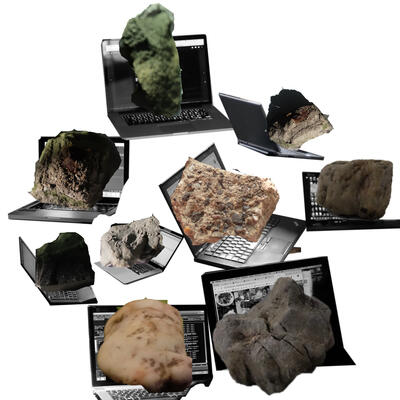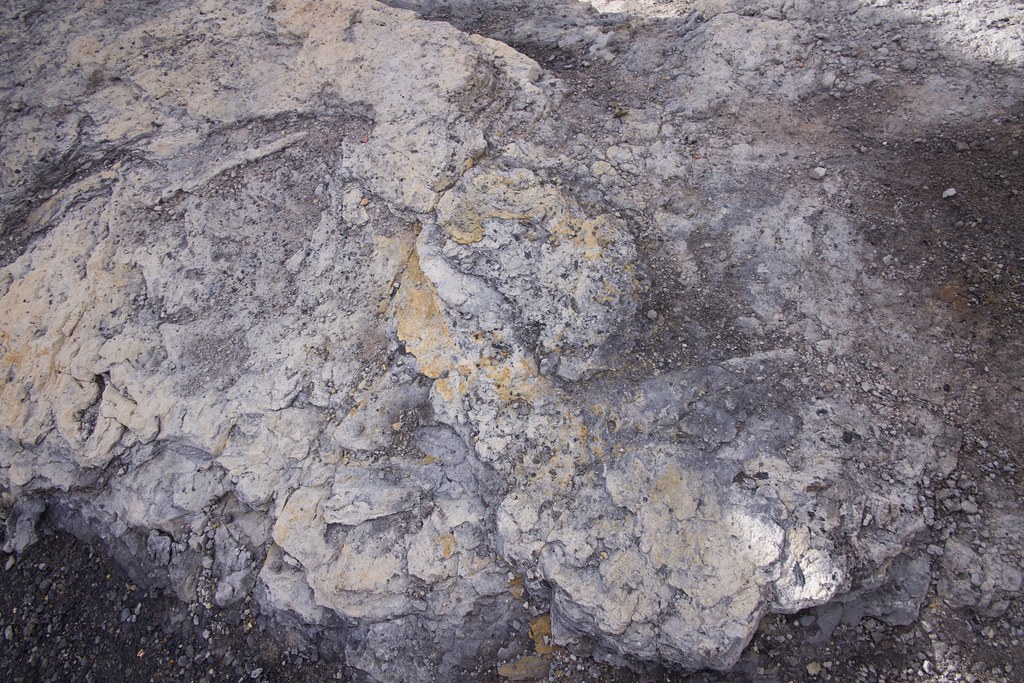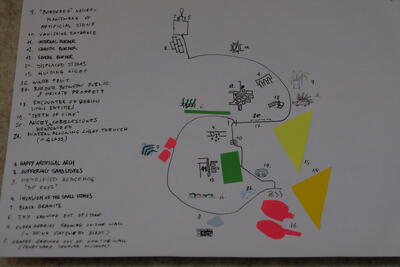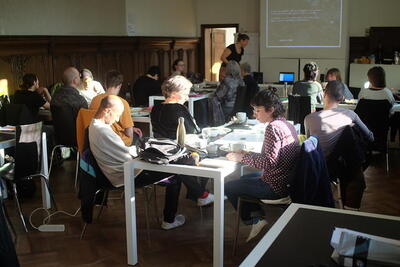Table of Contents
Attuning to Stones
For Alchorisma, Constant's work-session (2018-12-02 to 2018-12-08) looking at integrating cosmogenetic views with the charisma surrounding technology, FoAM focused on geological substrates of digital technology. From our temporary outpost in Japan, we invited the participants to work with attunement as a way to reestablish relationships with geological entities and glacial timescales, to experiment with algorithms to re-confuse binary distinctions between nature and culture, human and non-human, life and death.
Photos and collages from the worksession are made by Peter Westerberg.
Introduction
Listen to this introduction as a sound file
Welcome to the lithic attunement session. In the next few hours we will work with rocks, stones and geomancy as an entry point to practices of attunement with beyond-human timescales. We'll explore how charismatic and algorithmic approaches might function, break down, or diverge from experiences at a human scale. Before we begin, we'd like to cover a few key aspects of the session, namely the practice of attunement and the interactions between humans and minerals in the context of digital technologies.
Attunement can be uderstood as a particular sensitivity characterised by a careful, receptive, open awareness. It requires an active adjustment to entities or situations and assumes a willingness to be touched by external circumstances; to be lured, affected and changed by them. A deliberately hesitant engagement with other entities on their own terms, from quivering butterfly wings to earth-shattering volcanoes. Attuning relies on the human capacity to notice and participate in the asymmetrically reciprocal effects that occur in direct experiences in the world. A kind of “ecological intimacy”.
Although attunement can be an innate ability for some people, it can also be developed, enhanced and refined through practice. In a state of attunement, the world can be experienced teeming with life. It's a mutualistic or symbiotic state of being, one that accepts human interdependence with the planet as a given. We are immersed and implicated.
Attunement practices are common in animist cultures, and can be found throughout human societies. There are some obvious resonances with current philosophical tendencies of speculative realism or the long winding trails of panpsychism. Yet attunement is a concept that is often difficult to grasp in words, especially words that make sense outside of philosophical, ritual, performative or meditative discourses. It can most definitely not be abstracted as a set of algorithms. Exactly this slippery quality of attunement is what makes it interesting for this work session. This morning we'll explore attuning to the lithic entities in our surroundings.
When we talk about stones and rock, we talk about the thin, solidified crust of minerals that are part of the ground of the planet. Some of them are formed from recycled bodies of plants, animals and insects; some are the Earth's volcanic and sedimentary regurgitations, others are as old as the planet and the stars that gave birth to it. While you might see yourself as a very different being from the stone in your hand, minerals circulate through your body, shape your bones and support your digestion. When you die, you will return to the mineral realm. The organic dissipated into the inorganic. On a geological timescale human bodies are as much in a state of transition as wind, weather or lava. Flowing and temporary. We endure continuous erosion and our inevitable entropy. Geology and biology, geology and technology, our inner and outer topographies are inextricably entangled.
Alchemists understood this entanglement as a working hypothesis. In alchemy states and shapes of matter can be transduced, transubstantiated. Consider the transformation of minerals into knowledge, the creation of the philosopher's stone or the long, careful series of transformations required to create a portable computer. The alchemical union between matter and spirit suggests different relationships between hardware and software, between man-made and earth-grown technologies. Enchanted mathematical models and operational algorithms are already mythic signifiers able to influence cultures. If we take alchemy as a serious proposition, what could become possible that isn't otherwise? In contrast to contemporary geo-engineering, which often sees itself as separate from the world, alchemy understands the world as a web of delicate connections and convoluted relationships. In an alchemical worldview, technology is less about control and more about negotiation. As much as we sense the presence of a stone, the stone might be subtly affected by our presence. Alchemical technologies are akin to the grains of sand gradually negotiating their place among their neighbours and over time fusing into rock. A solidified pattern of stone emerging from the noise of sand dunes.
According to Arabic geomancers, the masters of “science of the sand”, patterns are already present in the noise, one just needs attune to their inherent dynamics. Geomancy is about reading the landscape, a kind of elemental scrying that suggests possibilities which are able to be influenced by the intentions of the practitioner. Geomancy does not offer solutions but propositions for possible future relationships between single human lives and an indifferent universe. An algorithmic pattern finding, a structured practice to focus intent and create meaning from the noise of matter.
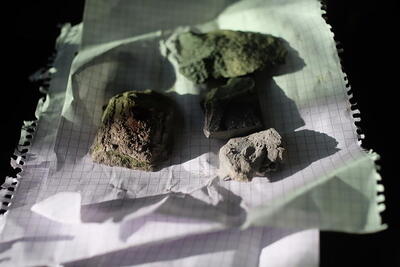 Our intention for this session is to explore different modes of engagement with the lithic, from experiential and associative, to abstract and analytical. The emphasis here is on the practice itself rather than achieving a specific goal. Practice is about directly experiencing something and reflecting on the experience in order to refine the practice, then repeating the process. Since we'll have limted time today, we can only skim the surface of these practices, but hopefully provide enough of a taste for you to take them further.
Our intention for this session is to explore different modes of engagement with the lithic, from experiential and associative, to abstract and analytical. The emphasis here is on the practice itself rather than achieving a specific goal. Practice is about directly experiencing something and reflecting on the experience in order to refine the practice, then repeating the process. Since we'll have limted time today, we can only skim the surface of these practices, but hopefully provide enough of a taste for you to take them further.
From a practical perspective, this morning will consist of a series of short exercises. We will provide step-by-step instructions and will be online to assist if you have any questions. We'd like you to begin with a psychogeological meander through the city, guided by patterns in, on and of stones. We suggest that you do this practice individually and in silence. You will get a chance to share your experiences and insights with others once you return. We will explore your individual associations, collective impressions and emerging alchorismatic processes. We will end the morning with a session for collective feedback. In the mean time, if you have any questions, comments or feedback for us, please put them on the etherpad.
Psychogeology
duration ~ 30 mins
(slide 1 can be found at → http://locust.fo.am/instructions-psychogeology.pdf )
A psychogeological meander guided by patterns in/on/of stones.
We assume you all know about psychogeography - exploration of urban environments that emphasize “drifting”, whereby you observe the effects of the geographical environment you're passing through on your emotions and behaviours. We invite you to do something similar, but focus specifically on the stones and rocks you encounter.
We suggest that you conduct this exercise individually and in silence. Spend some time exploring the city by following patterns in stones, bricks, rocks that draw your attention. Do not attempt to interpret them. Simply listen and observe what you're noticing. if you want you can record it, for example as a note, a drawing, a photo or a sound file. Move on when your attention is pulled towards another charismatic stone or geological pattern.
One by one leave the room. On your way out take a notebook and/or a digital recording device (camera, sound recorder, etc…).
Aim to be back in half an hour.
Collective work session
duration ~2h
(slides 2-6 can be found at → http://locust.fo.am/instructions-psychogeology.pdf )
When you return from the psychogeological drift, break-out into small groups (3-6 people).
1. Share what you have individually uncovered in the city. What did you experience? What did you notice? What does the city look like from the perspective of geological patterns? What algorithms could produce these patterns? duration ~20 mins
2. Collectively create an impression of the city from a lithic perspective, based on your associative memories. This could be a story, map, lapidarium and/or divination system for generative pattern recognition, for example. duration ~20 mins
3. Are there any algorithms that you could abstract from this work? Describe one of these algorithms as succinctly as possible. For example, as a list of instructions, a set of constraints, a grammar, a group of operations or transformations. duration ~20 mins
4. Exchange algorithms between the groups. How might your story/system/map/etc change if another group's algorithms are incorporated? duration ~20 mins
5. Collective feedback. What was easy to describe as algorithms? What fell outside of the algorithmic approach? What effect did applying another group's algorithm have on you? What is a lithic perspective? What might be appropriate to explore from the lithic perspective? duration ~30 mins

